
Improving Your Adwords Quality Score: How To Lower CPC & Raise ROI
Higher quality scores mean lower CPCs and better ad performance. Here are the components and how to impact them.
Google Adwords is expensive, and it can be very hard to create profitable Adwords campaigns. Most of our clients for our ppc management services come to us after having tried and failed to reach profitability with their Adwords campaigns, and one of the primary issues I find in these accounts is low keyword quality scores. Here is Google’s definition of quality score:
Quality Score is an estimate of the quality of your ads, keywords, and landing pages. Higher quality ads can lead to lower prices and better ad positions.
It is an easy-to-understand number from 1/10 to 10/10 score that estimates the quality of your performance. Creative naming, right? In their own definition, Google states that higher quality scores can lead to lower prices and better positions, so Google is directly saying you want to raise your quality scores. In this post I’m going to introduce you to quality scores in Adwords, break down the elements of Adwords quality scores, and share a number of steps you can take to improve your keyword quality score which will reduce your CPC, improve your conversion rate, and increase your Adwords ROI.
Introduction To Adwords Quality Scores
Quality score is the way for you to tell, at a glance, how your ads are performing in your account. It tells you what you need to work on, and the general improvements you can make that will give your ads better results.
Why is Keyword Quality Score Important?
Your quality score itself is important because it has an outsized impact on your cost-per-click compared to your competitors. Google uses your Quality Score to determine your Ad Rank, which is how they calculate how much you have to pay for your click. The higher your Quality Score, the less you have to pay for your ad click.
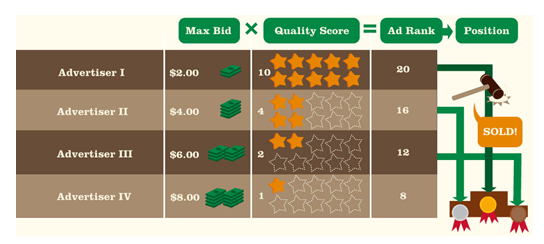
As you can see, the better your quality score, the better off you are. By increasing your quality score, you are showing Google that they should show your ad instead of someone else’s, even if it means they make less money.
The Elements of Quality Score
It is important to note that the keyword quality score elements you see are not the only elements that exist. Google factors in numerous other elements; however, they do not share exactly what they are. So while it is likely that the elements they outline in quality score are the most important, they are by no means all the elements. With that said, quality score is broken down into three components: ad relevance, landing page experience, and expected click-through-rate. Each of these can have a rating of below average, average, or above average. Now that you know what quality score is and what goes into it, let’s take a look at each element and how you can improve it to make more money with adwords!
Quality Score Component #1: Ad Relevance
Let’s go back to Google for their definition of Ad Relevance:
Ad relevance measures how closely related your keyword is to your ads.
That sounds pretty self explanatory, and it is. The more closely related your ad is to your keywords, the higher your ad relevance score. And the best part about ad relevance is that it is the easiest component of quality score to improve. If you have keywords for which your ad relevance is below average or average, bringing that score up to above average will be helpful in reducing your average cost per click. In general, there are two methods that we use to improve keyword relevance when working on an Adwords account, and either or both may need to be addressed in your account: too many keywords per ad group and poorly optimized ads.
Too many keywords
Having too many keywords in an ad group is a very common problem. For example, if you’re a moving company in New York City, you’re going to have keywords like “Brooklyn moving company” “Queens moving company” and “New York City moving company”. You may think these keywords are similar, but Google doesn’t think so. In Adwords, specificity is extremely important. If you have an ad group that lumps together Queens moving terms with Brooklyn moving terms and New York City moving terms, your ads will have low relevance.
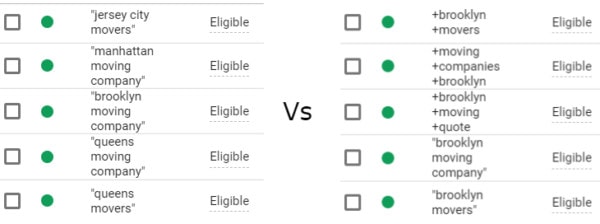
At a minimum, you would want to break this ad group into three ad groups, one for “Brooklyn” keywords, one for “Queens” keywords, and one for “New York City” keywords. In general, you want ad groups with fewer than 10 very closely related keywords. Any more than that and you will run into relevance problems. In fact, the holy grail of ad accounts are Single Keyword Ad Groups, where there is only one keyword per ad group!
Generic ads
While breaking up ad groups so the keywords within each ad group are as similar as possible will help improve ad relevance, often the text ads are simply too generic. If the keywords are similar, you can have ads that are highly relevant to all the keywords.

Let’s take a look at two different ads for our “Brooklyn Movers” ad group. On the left we have a generic ad, and it is the type of ad I often see in Adwords accounts before we optimize them. It doesn’t mention anything about Brooklyn. We don’t even know if the company does moves in Brooklyn. On the right we have a much better, highly relevant and targeted ad. We know the company operates in Brooklyn because they say so right in the ad. Ideally, you want your ad copy to include the keyword in both the headline, the description, and–if it fits–the display URL. Sometimes getting it exact can be tough, but the closer to exact the better. If you were looking for a moving company in Brooklyn, which ad would you click on? Once you’ve raised your ad relevance, the next component of quality score to address and optimize is improving your landing page experience score.
Quality Score Component #2: Landing Page Experience
Once again, I’m going to start with Google’s definition of Landing Page Experience:
A measure that Google Ads uses to estimate how relevant and useful your website’s landing page will be to people who click your ad. Landing pages with higher ratings are usually well organized and have text that relates to a person’s search terms.
I really like Google’s definition of a high quality landing page experience. And having great landing pages will pull double duty for you. Not only will a strong landing page experience help you get a high quality score, but it will help improve your conversion rate as well. We don’t know all of the elements that go into Google’s landing page experience metric, but we do know some of the major factors: landing page relevance, performance and user experience. I’m going to go over each of these factors to help you improve your landing pages. Not only will it help you get to above average landing page experience but it will increase your conversion rates as well!
Landing Page Relevance
Landing page relevance is much the same as ad relevance in that it is how similar the content on your landing page is related to the users search query. The more closely the landing page content is related to the query the person used, the better that is for this element of quality score. Higher relevance increase your conversion rate too! I’ll give an example. Let’s say I’m a coffee roaster who sells coffee beans online. I sell coffee beans both retail and wholesale, and I’m bidding on wholesale coffee keywords because I want to increase my wholesale business. I’m bidding on the keyword “wholesale arabica coffee beans” and a searcher clicks on my ad. Do I want them landing on the website homepage? No. The homepage isn’t relevant to their query. They’re not looking for a coffee bean company generally, they’re looking for something specific. They’re looking for wholesale arabica coffee beans. A much better landing page would be my wholesale coffee bean page. It is more relevant to their search. An ever better page? A wholesale arabica coffee bean landing page! Now you’re probably thinking that this kind of specificity means you need to create lots of tightly targeted landing pages. You’re right. If you want to make money with Adwords, you need to be amazing. The vast majority of Adwords campaigns lose money, so if you want to be one of the elite few who has profitable Adwords campaigns, you need extremely targeted landing pages.
Landing Page Performance & User Experience
But having high landing page relevance isn’t enough. Your landing pages also have to be technically sound and provide a great user experience. I could write another 2,000 word piece on on-page optimization, but I want to focus on a few, critical elements.
Page Speed
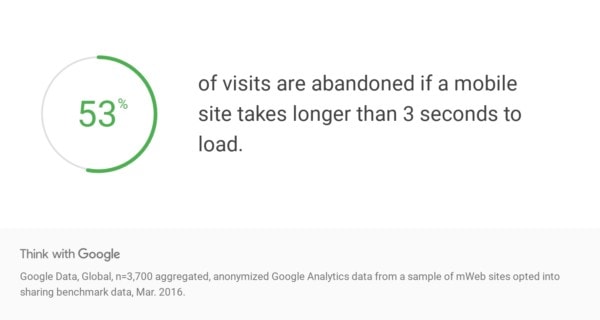
Your pages need to load quickly. As you can see from the data above, a majority of people expect pages to load in 3 seconds or less. If your landing page is taking 7, 10, or 15 seconds to load, people will click away. They aren’t going to wait. Google has a great tool to measure your page speed with recommendations on how to improve it.
Security
HTTPS is the new standard. Your entire website should be running on HTTPS these days. If your website isn’t secure, you’re being hurt in the organic rankings, and visitors won’t be trusting you. Google has said that HTTPS is a ranking factor. Your website MUST be on HTTPS. I’ve gone over how to move your site over to HTTPS on this blog in the past.
Layout and mobile friendliness
Your pages need to look good and be designed well. And if you’re showing ads on mobile devices, your pages have to be mobile friendly. Don’t skimp on your landing page design and usability. This can have an outsized impact on your conversion rates. Good landing page user experience is a big topic, but Unbounce has a great landing page analysis tool. (Full disclosure: We use Unbounce as our landing page software provider)
Quality Score Component #3: Expected CTR
Once again, we’ll go to Google for their definition of Expected CTR:
A keyword status that measures how likely it is that your ads will get clicked when shown for that keyword, irrespective of your ad’s position, extensions, and other ad formats that may affect the prominence and visibility of your ads. This status predicts whether your keyword is likely to lead to a click on your ads. Google Ads takes into account how well your keyword has performed in the past, based on your ad’s position. The expected clickthrough rate (CTR) that Google Ads provides for a keyword in your account is an estimate based on the assumption that the search term will match that keyword exactly. At auction time (when someone’s search terms triggers one of your ads), Google Ads calculates a more accurate expected CTR based on the search terms, type of device, and other auction-time factors.
Google likes high CTRs because it means they get a higher percentage of ad clicks which means they make more money. You like high CTRs because it improves your quality score, and it means you get more clicks from high performing keywords. Everybody wins! Raising your expected CTR is hard, and it’s an art as much as it is a science. One major thing you can do to improve your ad’s CTR is to create ads that are more relevant. So addressing ad relevance is going to not only improve your ad relevance QS, but it should also help with expected CTR as well. With that said, if your expected CTR is average, don’t fret. That’s just fine. What are some other things you can do to improve CTR?
Strong Calls-to-action
One element that is going to improve your ad’s CTR is a good call-to-action. If you don’t create ads with a strong CTA, you aren’t giving searchers a reason to click on your ad. Your text ads should always have a CTA. “Claim Your Free Trial Today!” and “Get A Free Quote!” are examples of strong CTAs. CTAs like “Learn More” or “Click here” are weak. If you’re having trouble finding good CTAs, you can always scope out what the competition are doing. Wordstream wrote a great blog post that discusses strong CTAs.

Ad Extensions
Google offers many different ad extensions you can setup to increase the amount of information in your ad. Ad extensions increase the size of your ad, and provide more helpful information for the user. You need to use ad extensions. Not only is using ad extensions a best practice, but it can also increase your CTR. Google offers many different types of ad extensions. As of writing this, there are 12 different ad extensions you can setup, and a handful more that are automated and done by Google. Not all ad extensions are relevant to every business, and you will have to decide which ones are relevant to you. However, some ad extensions are relevant to most businesses, including sitelink extensions, call extensions, and callout extensions. Structured snippet extensions and location extensions are also extremely common.
Sitelink Extensions
Sitelink extensions make your ad larger by including links to other, additional pages in your ad. Think of it like a mini navigation bar that accompanies your ad. You might be wondering why you would want additional links after we discussed how important strong, highly relevant landing pages are. Sometimes people are looking for slightly different information than you think based on their query. Or they’re in a slightly different stage of the buying process. Or the term they’re searching for is generic. Let’s go to the coffee example from earlier, except this time they’re searching for “buy coffee online.” I can serve an ad that is related to buying coffee online, but I don’t know exactly what they want. So in the sitelinks, I can include a link to our wholesale coffee page, our coffee subscription page, a page that goes into detail about our coffee and roasting process, and an FAQ page. These options give the searcher the ability to choose the page that is most relevant to them.

Call Extensions
Call extensions are relevant for many businesses. You might be a business that prefers phone calls over any other type of conversion. Call extensions allow you to have a phone number show up along with your ad on both desktop and mobile searches. Call extensions are particularly great for mobile searches, as people can click on the phone number and call directly from the ad. Additionally, you can also use Google’s call forwarding numbers which not only allow you to track call conversions, but you can see details about the calls right within adwords including the area code and the duration of the call.
Callout Extensions
Here’s what google has to say about callout extensions:
Promote unique offers to shoppers, like free shipping or 24-hour customer service with callout extensions. When customers see your ads, they get detailed information about your business, products, and services. This article gives an overview of callout extensions.

How callout extensions look[/caption]As mentioned in the definition, callout extensions are great for featuring small but important bits of information about your business and offering. Some examples of information to put into callout extensions include:
- Free shipping
- 24-hour customer service
- Free delivery
- Money back guarantee
- Price-match guarantee
- In-store pickup
Take a look at the many different extensions offered by Google, find the ad extensions that are relevant to your business and make sure you set them up!
Tying it all together
Now that you’ve done everything above to improve your keyword quality score and have improved the way your ads perform, can you rest on your laurels? You cannot! There are always improvements you can make to your Adwords account. The difference between a successful ad campaign and an unsuccessful one is optimization and refinement. You should almost always be split testing ads and landing pages to continue to improve your Adwords performance. Have questions about how to raise your quality score and improve your Adwords performance? Leave a comment below or send us an email.
Stay in the loop! Sign up to get our newest blog articles and exclusive resources delivered straight to your inbox.
Newsletter Signup
Related Articles
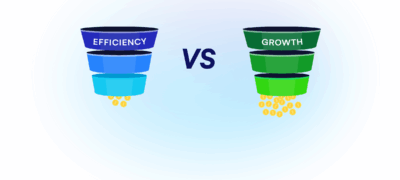
- PPC
Your Google Ads Metrics Look Great, So Why Aren’t You Growing?
At a glance, everything looks great. Your Google Ads account is hitting ROAS targets. Spend is stable and efficient. Branded search…
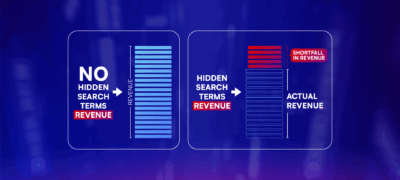
- PPC
The High Cost of Hidden Search Terms: How Google Skims Profit from Advertisers
Google claims that search terms are hidden for privacy reasons and not performance reasons, so we wanted to find out: Do…

- PPC
- Paid Social
- CRO
Flat Fee Agency Retainers Are Killing Your Brand’s Growth
If you’re working with a digital agency that charges you a flat monthly fee, they’re either overcharging you now or they’re…
How can we help you grow?



